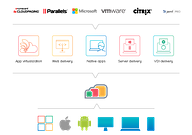Reduce or right-size VDI

Reduce, replace or 'right-size' your existing VDI environment.
Most universities and colleges come to us looking for an alternative or replacement to VDI. Many of our customers have tried an expensive VDI solution or some sort of layering technique to deliver all of their apps to students and staff...
Pixel streaming is not the best way to deploy an app to your students. Fact.
Virtual desktop infrastructure vendors often sell VDI as a solution to application deployment problems; positioning it as the silver bullet to the "any application, any device" dream. The reality is that VDI is meant for the desktop; it's not really designed to deliver apps, especially graphics-intensive software that's highly demanding and commonly used in Higher Ed.
Universities who've tried VDI or some form of desktop virtualization have found they had massive images and were constantly maintaining and feeding the VDI image monster, opening up an entirely new problem for many IT departments: 'VDI sprawl'.
On top of that, the costs involved with the required infrastructure are beyond the realms of possibility for many universities or colleges, and that's even with education pricing! The end result is that many universities use a little bit of VDI, maybe in certain faculties or campuses. But because it's so expensive and difficult to scale, Higher Ed can't deliver all applications to all students both on and off campus, on any device.
Avoid dreaded 'VDI sprawl'
The more that universities try to reach the "any app, any device, anywhere" dream, the more that VDI becomes troublesome. 'Gold images', app layering and VDI sprawl all become major issues when rolling out a desktop virtualization solution campus-wide; and that's before you consider BYO devices! Deliver apps to devices on-demand instead and do away with any VDI sprawl...


The benefits of VDI for less cost
AppsAnywhere helps university and college IT achieve the end-user computing dream; delivering any application to students on any device, anywhere. But it does it at a fraction of the cost of infrastructure-intensive desktop virtualization solutions, all with a better student experience.
Students hate virtual desktops
Students hate VDI for one of two reasons. Either because of the poor performance of the apps available through VDI, or because universities only make VDI available to certain students or faculties (because of cost). Give all students equitable access to academic apps on and off campus and improve student outcomes.


Take advantage of student-owned devices
Most students come to university with their own, high-spec laptop, ready to do their coursework. Instead of running academic applications on an expensive centralized server farm, deliver virtualized apps to BYO devices and make the most of their local computing power.
Enhance or replace your existing virtualization environment.
AppsAnywhere can be used in conjuction with any VDI or RDS solution, including VMware, Citrix, WVD and Parallels RAS. That means your university can deploy apps in a number of different ways, all through a consistent and beautiful platform, available to access on any device on and off campus. It also means you can migrate away from those technologies with minimal impact on your students.

How is VDI used in Higher Education?
VDI can sometimes be used at a university or college to:
- Provide a consistent desktop experience to all users
- Allow desktops to be spun out quickly to users, on-demand
- Offer greater flexibility of dedicated lab spaces
The benefits of AppsAnywhere's application virtualization technology, either used alongside VDI or as an alternative to VDI, are similar to that of a physical desktop. If operating multiple images it allows you to scale this back, ideally to just one image. It then allows you to significantly reduce this image size, remove conflicts between apps and deliver apps on-demand, where and when they're needed.
There are of course times when you might want to use some VDI within Higher Ed. We acknowledge this and have built AppsAnywhere to integrate with all the leading desktop virtualization providers, so you can still give students a single point of access on any device for all their applications, while scaling your app delivery solution campus-wide.
Slash ongoing VDI costs...
AppsAnywhere can be used alongside an existing virtual desktop infrastructure (VDI). By doing so you can take the apps out of the VDI image and deliver them separately, so they run on the local machine. That means your apps run more smoothly, you save huge amounts on expensive VDI equipment, and your students' experience is awesome.

Using AppsAnywhere to right-size or replace VDI
A number of our customers use AppsAnywhere alongside VDI to get the benefits listed above, but what we always see is that once implemented, questions are asked as to why VDI is still required. AppsAnywhere is a great solution for use within a VDI, but there are even greater benefits outside of the VDI environment, where running apps locally will offer a far superior user experience with less reliance on expensive server farms or infrastructure.
Most VDI vendors recommend some form of application virtualization as the delivery mechanism within a VDI. That's because providing 100% of applications using the virtual desktop infrastructure isn't a realistic possibility, especially within a university environment where IT needs to deliver and support 100s of different types of applications, some hugely complex and some that are still written in DOS!
AppsAnywhere's 'application virtualization' solution enables the delivery of 100% of Windows apps, even those with dependencies or those requiring access to drivers, plugins, or old versions of Java for example. It does this with a minimal backend infrastructure, and harnesses the power of the end-user's device to run the software. That means that...
- For students: the software runs and performs as if installed
- For IT: no heavyweight server farm is needed and VDI images are reduced
How our customers have reduced VDI costs...

The Slow Demise of VDI (and The Rise of The University App Store)
VDI: One of the stand-out technologies of the decade. The promise? To deliver end user IT services wrapped inside a remote desktop window. It was everyone's dream, but was a promise that never delivered.

Solving Two Major VDI Challenges at Le Moyne College, New York
Phil Spitze, Senior System Administrator at Le Moyne College New York, talks about how they used AppsAnywhere to solve two major VDI challenges; Gold Image Bloat and VDI Pool Sprawl.

What's after VDI? Replacing virtual desktops with application virtualization at PSU
Like many other universities, Pitt State originally chose VDI as the best solution to deploy apps to students. After realizing that performance is patchy and costs are astronomical, the university sought another technology.